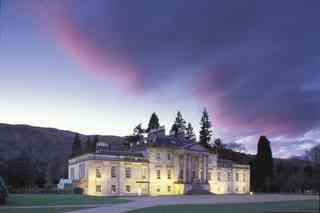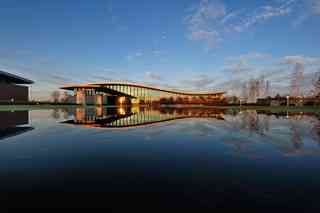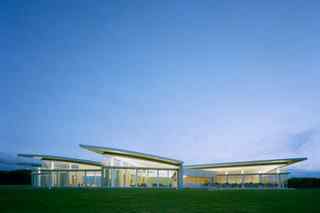December 10,2022
The Best Golf Clubhouse Architecture
by David Stewart

Loch Lomond Golf ClubDunbartonshire, Scotland
Situated on a lakeside estate that used to be home to the Colquhouns, a Highland Scottish clan, Loch Lomond’s clubhouse is built of local pink and yellow sandstones—some of which had been salvaged from the clan’s 18th-century Georgian-style Rossdhu Mansion. To keep their spirit alive, the Colquhouns, who lived on the 660-acre estate throughout the 1970s, lent original artwork and furniture to the estate after it was reimagined as a golf course in 1994.

Jack Nicklaus Golf ClubNew Songdo City, South Korea
Iranian architect Mehrdad Yazdani ’s clubhouse vision for South Korea’s first Jack Nicklaus golf development, which opened in 2010, is about as chic as golf gets. Fitted with curved zinc roofs, the pavilions sit on neutral-color stone plinths and feature pilasters made from local Merbau wood that minimize glare and heat gain. Inside, it’s all marble floors, bead-blasted stainless-steel columns, and limestone wall panels. The combined effect is, as Nicklaus says, “Something very unique and very special.”

__The BridgeBridgehampton, New York__
Constructed on the site of a former racetrack in 2010, the boldly modernist 40,000-square-foot glass-walled clubhouse at the Bridge boasts unparalleled views of the Rees Jones –designed course—through louvered and sustainably sourced cypress shutters. The interiors of the turbine-bladed Roger Ferris + Partners –designed two-story structure are equally stunning, showcasing works from such blue-chip artists as Richard Prince and Tom Sachs (both of whom are members of the club).
King Kamehameha Golf ClubMaui, Hawaii
Celebrating its 20th anniversary this year, the KKGC clubhouse, with its iconic porthole windows and desert-rose skin, is one of only two Frank Lloyd Wright designs on the Hawaiian islands. Originally intended to be the 14,000-square-foot Connecticut home of Arthur Miller and Marilyn Monroe, the plans were later acquired by the club’s developers, who expanded the footprint to 74,778 square feet. Though the course, cradled in the foothills of the West Maui Mountains, is private, the clubhouse is open to the public and features African-mahogany casework, a stained-glass skylight depicting butterflies, and a stunning collection of Hawaiian art, including Herb Kane’s epic panel painting of Kamehameha and his chiefs.
Royal Birkdale Golf ClubSouthport, England
Though it’s received some recent updates, the Art Deco–style clubhouse at Royal Birkdale still retains much of architect George Tonge’s 1935 shiplike design. Dry-docked on England’s Southport dunes, this massive cinder-block edifice was originally equipped with its own card room, smoke room, and billiard room. As one reporter remarked at its opening, “Standing on the promenade deck overlooking the Irish Sea it needs little imagination to feel that one is on a cruise.”
Medinah Country ClubMedinah, Illinois
Chicago-born architect Richard Gustav Schmid was renowned for crafting pre-Depression-era buildings that incorporated Byzantine, Oriental, Louis XIV, and Moroccan flourishes. One of his most celebrated designs is the 1926 redbrick and green-roofed clubhouse at Medinah Country Club, whose famed Course #3 has played host to numerous PGA events, including the 2012 Ryder Cup. Reportedly modeled after a Turkish mosque, the structure is capped with mock minarets and a dramatic domed rotunda. (Inside, the rotunda features a mosaic painted by the German artist Gustav A. Brand*.) *
The Hills Golf ClubArrowtown, New Zealand
A finalist for the 2008 World Architecture Festival, the neo-Brutalist bunker at the Hills is constructed of 200 tons of meter-thick concrete and schist rocks sourced from local rivers. Built in 2007 to host the New Zealand Open, the course is set at the base of the Remarkables Mountains in the former gold-mining town of Arrowtown on New Zealand’s South Island. The wedge-shaped building, known as the Divot, sits three quarters belowground, and were it not for the fire pits and double-glazed glass walls, it might well be invisible.
Stoke Park Country ClubBuckinghamshire, England
Situated on a nearly 1,000-year-old estate, the Palladian white stone mansion at Stoke Park was designed by George III’s architect, James Wyatt. The building remained a private residence until 1908, when it was sold and turned into a clubhouse for Britain’s first country club. Boasting palatial terraces, marble pillars, period paintings, antique furnishings, and views of Windsor Castle, not to mention having hosted many famous rounds—James Bond tees it up here in the 1964 film *Goldfinger—*it’s the closest duffers can get to royalty.
__Oijared Country ClubFloda, Sweden__
Featuring a naturally ventilated living roof, geothermal heating, and a 36-sided glass façade, Swedish architect Gert Wingårdh ’s sunken clubhouse at Oijared redefines green design. Built in 1988 and inspired by Argentine talent Emilio Ambasz’s subterranean masterpieces, the structure comprises six levels, with exterior walls that seem to cut into the forested landscape like a Robert Grosvenor sculpture.
Royal Lytham & St. Anne’s Golf ClubLancashire, England
Built in 1897, this green-trimmed redbrick clubhouse was once described as “the former residence of Count Dracula”—surely a reference to the punishing, trap-laden George Lowe–designed course that has stymied so many British Open champs and not the edifice’s Tudor-style architecture. With billiards, books, and a wide selection of beers in the wood-paneled Club Room, it’s difficult to imagine a more inviting 19th hole.
__Olympic Golf Course ClubhouseRio de Janeiro__
Last played at the 1904 Olympics in St. Louis, golf finally returns to the Summer Games in 2016 at a 72-hole course in Rio de Janeiro’s lush Barra de Tijuca district. Local firm RUA Arquitetos designed the tropical modern clubhouse, which boasts interior gardens, a wheelchair-accessible rooftop lounge, and a translucent canopy with a rainwater-catchment system that helps irrigate the mangrove-filled course. Construction is scheduled to be finished in December 2014, and following the Games, the course will be open to the public.
Formby Golf ClubLiverpool, England
Destroyed by an 1899 fire, the clubhouse at Formby was reconstructed two years later by Liverpudlian architecture firm Haigh, Marmon & Thompson. Set amid terrain dotted with pine trees, the building features a now-iconic clock tower that was a gift to the club in 1909 from White Star Line chairman Joseph Bruce Ismay—later known as the Coward of the Titanic —to mark its 25th anniversary. The structure was expanded in the ’90s with an Arts & Crafts–inspired west wing.
__The Blessings Golf CourseJohnson, Arkansas__
Arkansas architect Marlon Blackwell did much to up the Ozark region’s design cred—not to mention golf’s—with the Blessings’s cantilevered clubhouse, built in 2004. While the industrial-style exterior is made of dry-stacked stone and wrapped-copper panels, the interior resembles a Zen temple with walnut and cherry woodwork and glass curtain walls that offer panoramic views of the Robert Trent Jones Jr.–designed course. There’s even a soothing green-tiled double-height spa in the locker room to help rid oneself of any lingering memories of bogeys.
Sunningdale Golf ClubBerkshire, England
First known as Ridgemount, Sunningdale’s quaint brick-and-shingle clubhouse was originally built as a home by developer brothers and club founders Tom and George Roberts. Though the Harry Colt–designed course has welcomed the European and British Women’s Open in recent years, the sepia-tone photographs lining the clubhouse walls and the gabled clock overlooking the 18th green keep things firmly rooted in nostalgia.
Old Course at St. AndrewsSt. Andrews, Scotland
Considered to be the Vatican of the golf world by players around the globe, the Royal & Ancient Clubhouse at St. Andrews may well be the most hallowed architectural marvel in all of sports. Architect George Rae’s 1854 neoclassical clubhouse, which attends to the links where the game was born, has undergone eight expansions over the decades—additional floors, wings, and the iconic bay windows have all been added.






